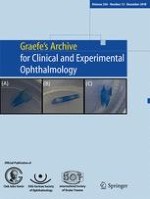Published in:

01-12-2018 | Pediatrics
Lateral rectus muscle recession for intermittent exotropia with anomalous head position in type 1 Duane’s retraction syndrome
Authors:
Ju-Yeun Lee, Kyung-Ah Park, Sei Yeul Oh
Published in:
Graefe's Archive for Clinical and Experimental Ophthalmology
|
Issue 12/2018
Login to get access
Abstract
Background
We questioned how to treat for intermittent exotropia in type 1 Duane’s retraction syndrome (DRS). To avoid secondary abduction deficit and late overcorrection on the affected eye following ipsilateral lateral rectus (LR) recession, we performed less correction of the lateral rectus (LR) recession to correct exodeviation and anomalous head position (AHP). We report the surgical outcomes of LR recession in patients with unilateral type 1 DRS.
Methods
Four patients who underwent less correction of LR recession in the affected eye to correct intermittent exotropia and AHP to the contralateral side in type 1 DRS were enrolled. Data on preoperative and postoperative angle of exodeviation, degree of AHP, ocular motility, global retraction, palpebral fissure change, and complications were retrospectively obtained. Success was defined as postoperative deviation within 8 prism diopters (PD) and AHP < 5°.
Results
The preoperative angles of exodeviation and AHP were significantly improved after LR recession. The median grade of abduction limitation was improved from − 1.3 to − 0.8 postoperatively. Final median value of deviation was orthotropia in the primary position of the eye with the normal motility. All patients had successful outcomes without overcorrection or further abduction limitation in DRS eyes.
Conclusions
Less correction of ipsilateral LR recession may be useful for correcting intermittent exotropia and AHP in patients with type 1 DRS.





